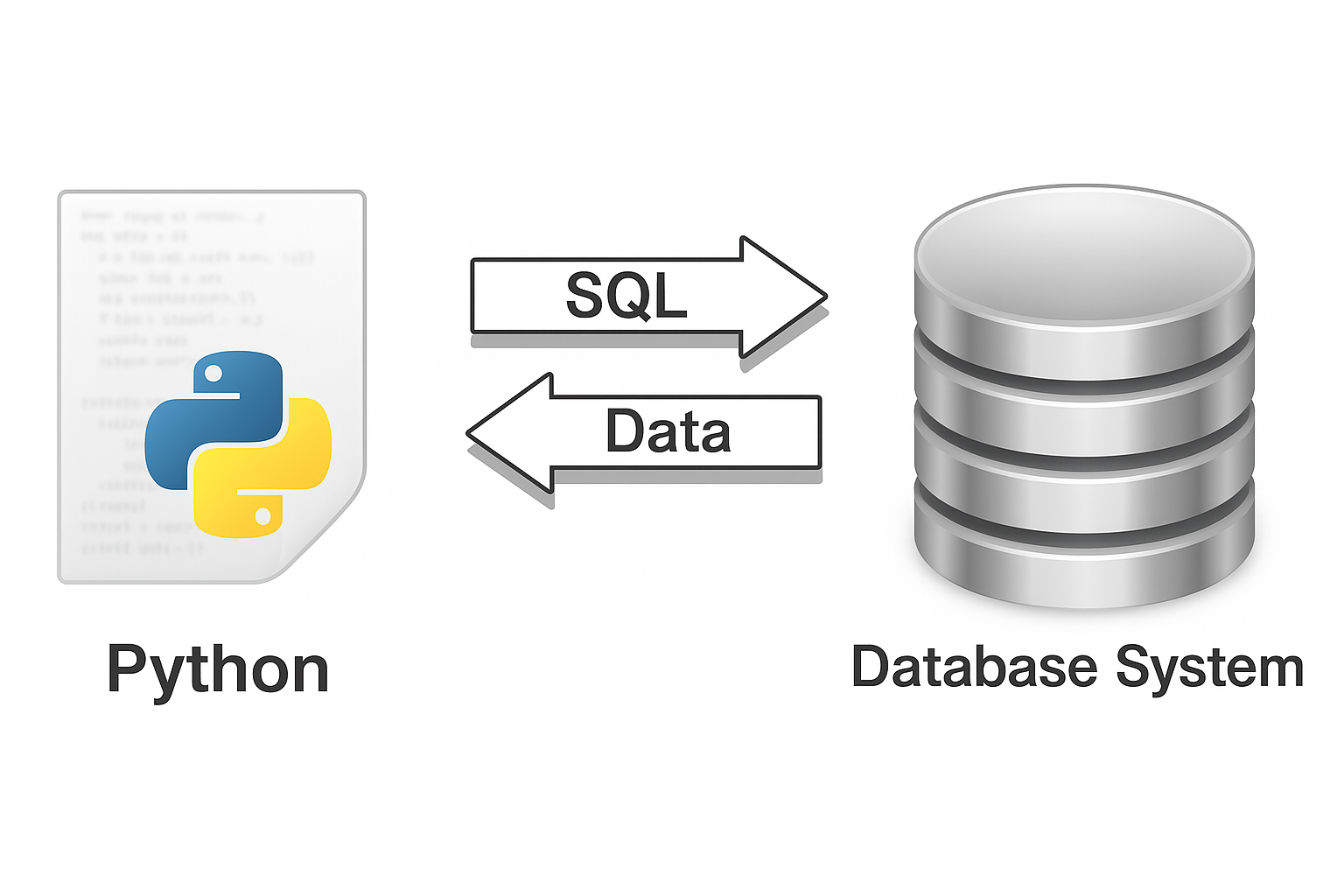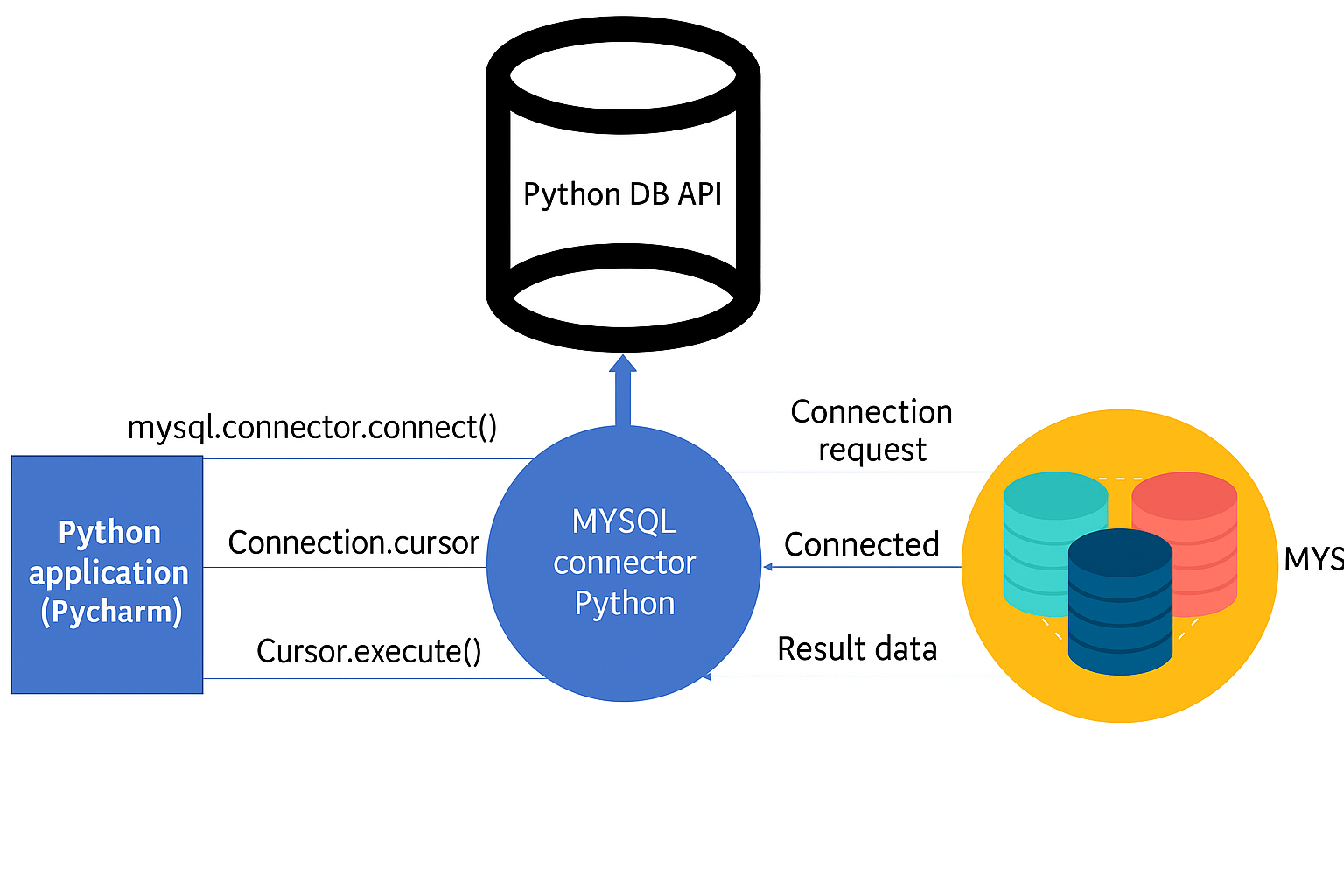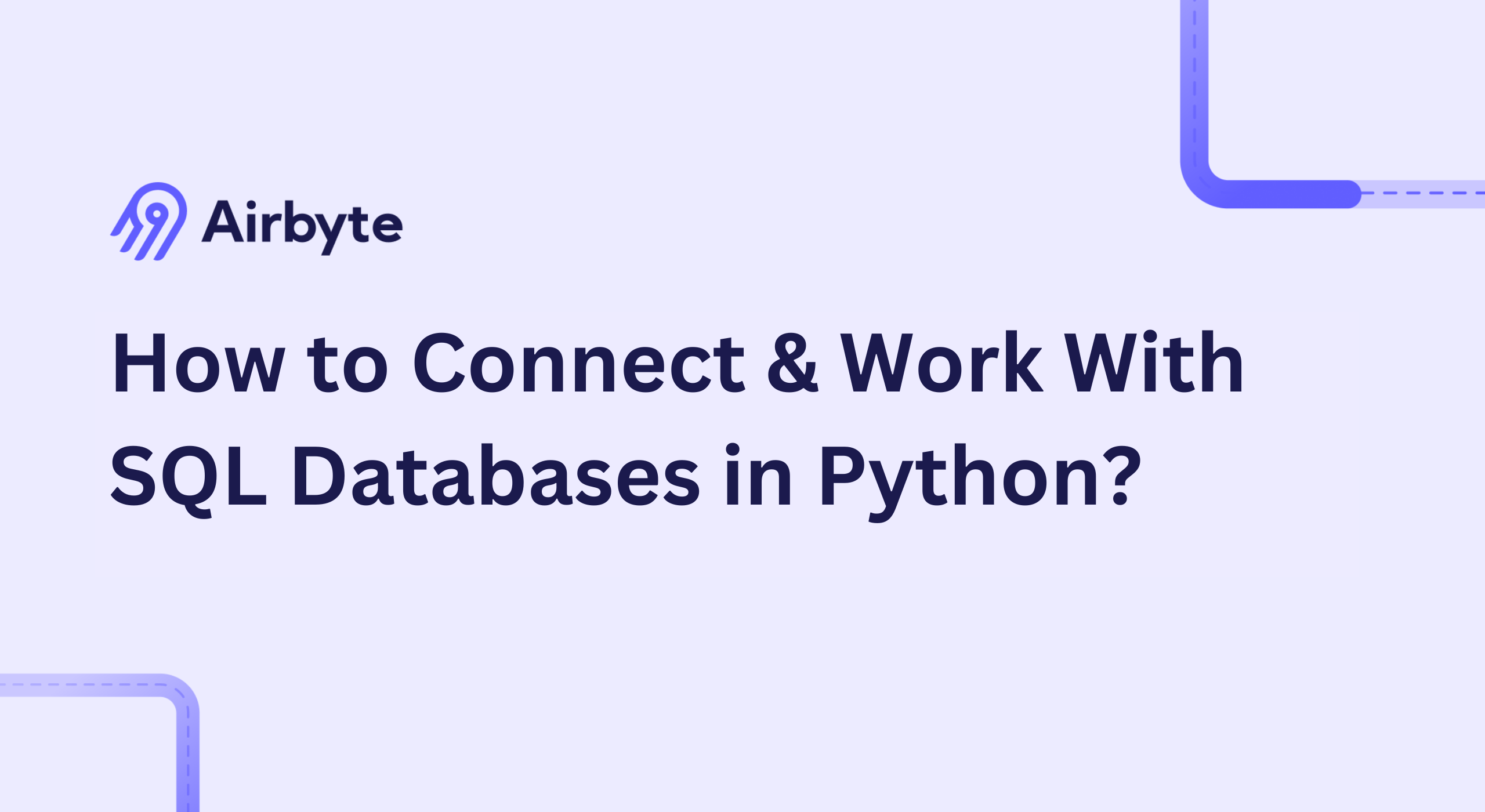How to Connect and Work with a SQL Database in Python
Summarize this article with:
✨ AI Generated Summary
Python enhances SQL database operations by combining SQL's structured management with Python's flexible libraries, enabling efficient CRUD operations, advanced analytics, and real-time data processing through asynchronous patterns. Key practices include parameterized queries for security, connection pooling for performance, and batch processing for optimization. Tools like Airbyte further simplify data integration with pre-built connectors, schema management, and enterprise-grade security, allowing data teams to focus on analysis rather than infrastructure maintenance.
Working with data today often feels like balancing two competing demands: keeping pipelines reliable while also unlocking insights that drive strategy. Many teams find themselves slowed down by manual processes, fragmented tools, and constant troubleshooting just to keep their SQL databases connected and accessible.
Python changes that equation. Its ecosystem of libraries and straightforward syntax make it possible to handle everything from simple queries to large-scale, real-time data pipelines with less friction. By combining SQL’s structured data management with Python’s flexibility, you can move from repetitive database tasks to building workflows that scale and support advanced analytics.
This guide walks through how to connect SQL databases with Python, perform core operations, adopt asynchronous patterns, and implement security and performance best practices—equipping you with practical techniques to streamline your data work.
Why Is Python Ideal for SQL Database Operations?
An extensive set of libraries makes Python a popular choice for performing SQL operations, especially in use cases requiring data analysis and engineering tasks. Some of the most common analytics libraries Python offers include Pandas, NumPy, Matplotlib, scikit-learn, and TensorFlow. These libraries allow you to model and visualize complex datasets.
To leverage these libraries, you must first integrate data from the required source into the Python environment. Most organizations use relational databases like MySQL, Oracle, PostgreSQL, and more to store data efficiently. Python supports various database drivers that you can import into your local system to connect and work with these databases.
Due to its simplicity in handling data, you can efficiently perform create, read, update, and delete operations on your database. Python's interpreted nature enables rapid prototyping and iterative development, making it ideal for exploratory data analysis and dynamic query generation. The language's strong community support ensures comprehensive documentation and continuous improvement of database connectivity libraries.
When Should You Use SQL Database with Python?

SQL databases are commonly used with Python when you require robust data storage, transformation, and analytics capabilities. Here are a few use cases for Python SQL integration:
- ETL Operations: With the powerful features of Python, you can extract and transform raw data from different sources, including CRMs and ERPs. This processed data can then be bulk-stored in your SQL database within the same development environment.
- Advanced Analytics: You can also use Python to extract data from your SQL database and perform advanced analytics to produce actionable insights.
- Robust Data Structures: By leveraging various Python data structures, you can organize and store data for efficient manipulation and enhanced accessibility.
- AI Application Development: Using SQL databases in Python makes it easier for you to train large language models on your stored organizational data.
- Real-time Data Processing: Python's async capabilities enable real-time data pipeline creation where database operations don't block application performance.
- Cross-Platform Integration: Python's database drivers support multiple platforms, enabling seamless integration across different operating systems and cloud environments.
How Do You Connect to SQL Database Using Python?

Installing Libraries
Importing Necessary Libraries
Connecting to SQL Database
Creating an SQL Database
Connecting to the Database
Create a Query-Execution Function
How Do You Perform Basic SQL Operations with Python?
Creating Tables
CRUD Operations
- Create – insert new data
- Read – retrieve data
- Update – modify existing data
- Delete – remove data
Inserting Data
Reading Data
You can also perform read operations with advanced SQL concepts like JOIN. For deeper analysis, convert results to a pandas.DataFrame.
Updating Records
Deleting Records
What Are Asynchronous Database Operations and Why Do They Matter?
Modern Python applications increasingly require asynchronous database operations to handle high-concurrency workloads without blocking execution. Traditional synchronous database operations create performance bottlenecks in applications serving multiple simultaneous users or processing real-time data streams.
Understanding Async Database Patterns
Asynchronous database operations use the async/await syntax to enable non-blocking I/O, allowing your application to handle thousands of concurrent database connections efficiently. This approach becomes essential when building web APIs, real-time analytics dashboards, or data processing pipelines that must maintain responsiveness under load.
Connection Pooling for Production Environments
Connection pooling prevents resource exhaustion by reusing database connections across multiple operations. Modern applications require sophisticated pool management to balance performance with resource consumption.
Performance Benefits and Use Cases
Asynchronous operations deliver substantial performance improvements for I/O-bound database workloads. Applications processing high-volume transaction data, real-time analytics, or serving multiple concurrent users benefit from async patterns that eliminate blocking operations. The async approach enables single-threaded applications to handle workloads traditionally requiring multiple threads or processes, reducing complexity while improving throughput.
How Can You Implement Advanced Security and Performance Optimization?
Modern python SQL implementations must prioritize security and performance to meet enterprise requirements. This involves implementing parameterized queries, connection security, and performance optimization techniques that prevent common vulnerabilities while ensuring scalable operations.
Parameterized Queries and SQL Injection Prevention
Parameterized queries represent the most critical security practice for preventing SQL injection attacks. Never construct SQL queries using string concatenation or formatting with user input, as this creates vulnerability to malicious code execution.
Encrypted Connections and Authentication
Production database connections must use encrypted communication to protect data in transit. Configure SSL/TLS encryption and implement proper authentication mechanisms to prevent unauthorized access.
Connection Pooling and Resource Management
Proper connection pooling prevents resource exhaustion while optimizing database performance. Configure pool sizes based on your application's concurrency requirements and database server capacity.
Batch Operations and Performance Optimization
Optimize database performance through batch operations, proper indexing strategies, and efficient query patterns. Batch processing reduces network overhead and improves throughput for bulk operations.
How Do You Handle Change Management with SQL and Python Integration?
What Techniques Help Handle Large-Scale SQL Databases in Python?
- Use libraries like NumPy for efficient in-memory array operations.
- Read large tables in chunks with
pandas.read_sql(..., chunksize=N). - Leverage database-side partitioning and caching (e.g., MySQL
PARTITION BY,query_cache_limit). - Implement streaming result processing to avoid loading entire datasets into memory.
- Use database-specific optimizations like connection compression and prepared statements.
- Consider read replicas for analytical workloads to reduce load on primary databases.
How Do You Optimize Queries When Using Python?
- Select the right database engine (scalability, security, compatibility).
- Use Object-Relational Mapping (ORM) tools for connection pooling, caching, and batch operations.
- Add indexes on frequently filtered or joined columns.
- Write precise queries—avoid
SELECT *, useWHEREandLIMIT. - Implement query result caching for frequently accessed data.
- Monitor query execution plans and optimize based on performance metrics.
- Use database profiling tools to identify bottlenecks and slow queries.
What Challenges Might You Face and How Can You Solve Them?
- Driver availability: verify that a maintained Python driver exists for your database.
- Authentication errors: double-check host, port, user, and password.
- Data-type mismatches: ensure Python objects map to SQL-compatible types when inserting or updating.
- Connection timeouts: implement retry logic and proper connection management.
- Memory limitations: use streaming queries and pagination for large result sets.
- Security vulnerabilities: always use parameterized queries and encrypted connections.
- Performance degradation: implement proper indexing and query optimization strategies.
How Can Airbyte Simplify Your Data Integration?
Airbyte transforms how organizations approach data integration by solving the fundamental problem of effectively managing and integrating data across diverse enterprise environments. Rather than forcing you to choose between expensive proprietary solutions and complex custom integrations, Airbyte provides an open-source platform that combines flexibility with enterprise-grade security and governance.

Key features include:
- 600+ Pre-built Connectors: Comprehensive connector library covering databases, APIs, files, and SaaS applications with community-driven development that rapidly expands integration capabilities.
- Schema Management: Configurable schema change management that automatically handles evolving data structures without pipeline disruption.
- Change Data Capture (CDC): Automatic replication of incremental changes from source databases, enabling real-time data synchronization with minimal latency.
- AI-Powered Connector Builder: Advanced connector creation capabilities demonstrated in this AI-assist demo that accelerates custom integration development.
- PyAirbyte: An open-source Python library for extracting data into analysis-ready caches, enabling seamless integration with your existing Python workflows.
- Vector Database Compatibility: Native integrations with Pinecone, Weaviate, Milvus, and other vector databases for AI and machine learning applications.
- Enterprise-Grade Security: End-to-end encryption, role-based access control, and compliance with SOC 2, GDPR, and HIPAA requirements.
Airbyte processes over 2 petabytes of data daily across customer deployments, demonstrating production-ready scalability for enterprise workloads. The platform's open-source foundation eliminates licensing costs while providing deployment flexibility across cloud, hybrid, and on-premises environments.
Conclusion
Using a SQL database in Python addresses the critical challenges facing modern data professionals, from reducing manual integration overhead to enabling sophisticated analytics that drive business value. Python's robust ecosystem of database drivers, ORM frameworks, and async capabilities provides the foundation for building scalable, secure data operations that eliminate the bottlenecks hampering data team productivity.
By implementing the techniques covered in this guide—from basic CRUD operations to advanced asynchronous patterns and security optimizations—you can transform time-consuming database tasks into automated, efficient workflows. The integration of modern practices like connection pooling, parameterized queries, and batch processing ensures your Python SQL implementations meet enterprise performance and security requirements.
Tools like Airbyte further amplify these capabilities by providing pre-built connectors and automated data integration pipelines that eliminate custom development overhead. This combination of Python's flexibility with proven integration platforms enables data teams to focus on high-value analysis rather than infrastructure maintenance, directly addressing the burnout and inefficiency challenges plaguing the data profession.
The path forward involves embracing these modern patterns while maintaining focus on security, performance, and scalability—ultimately creating data infrastructure that serves as a competitive advantage rather than an operational burden.
FAQ Section
What is Python SQL integration?
Python SQL integration is the process of connecting Python applications with SQL databases so you can query, update, and manage data programmatically. This allows you to automate workflows and apply Python’s data analysis libraries directly to structured data.
Which databases can I use with Python?
Python supports most popular relational databases, including MySQL, PostgreSQL, SQLite, Oracle, and SQL Server. It also offers drivers and ORM frameworks that simplify connectivity and operations across different environments.
Why use Python instead of SQL alone?
SQL is excellent for managing and querying data, but Python adds flexibility for automation, data transformation, machine learning, and visualization. Together, they allow you to go beyond querying and into building scalable, analytics-ready systems.
How does Python improve database performance?
Python enables practices like asynchronous queries, connection pooling, and batch processing, which reduce resource strain and improve efficiency. It also integrates with libraries that help manage large datasets in memory without overwhelming system resources.
What role do tools like Airbyte play?
Airbyte extends Python SQL workflows by handling data integration at scale. With pre-built connectors, CDC replication, and schema management, it removes the overhead of custom ETL development while keeping pipelines reliable and compliant.

.webp)
